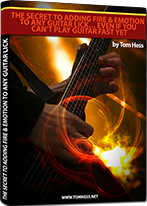Songwriting - Part 3
by Tom Hess
Emotion To Any Guitar Lick

EMAIL TO GET ACCESS
By submitting your info, you agree to send it to Tom Hess Music Corporation who will process and use it according to their privacy policy.
By now, you have probably figured out that these three articles on songwriting are on a more advanced level than is typical of songwriting articles or most books.
Emotion To Any Guitar Lick

EMAIL TO GET ACCESS
By submitting your info, you agree to send it to Tom Hess Music Corporation who will process and use it according to their privacy policy.
Begin With Rhythm First
Combinations
Combine 2 or more completely different rhythmic ideas into a single idea. Take two of your favorite rhythmic patterns and combine them into a single idea.
Augment Rhythmic Values
Create a short rhythmic pattern one measure in length. Write it down on paper. Now increase the value of each rhythmic event (note or rest). Here is an example. Let’s say you have this pattern: One quarter note, two 8th notes, another quarter note, then four 16th notes. Now "augment" all of these rhythmic notes by doubling their length.
Change all quarter notes to a half notes.
Change all 8th notes to quarter notes.
Change all 16th notes to eighth notes.
The example above now gives you a rhythmic pattern that is slower and twice as long but using the same number of events and the exact same pattern (just slower now).
 Become A Much Better Songwriter
Become A Much Better SongwriterLearn new and innovative ideas to
quickly improve your songwriting.
 Why To NOT Write Music That Sells
Why To NOT Write Music That SellsLearn why you should write music
you like rather than what 'sells'.
 Studio Recording Guide For Guitar
Studio Recording Guide For GuitarLearn how to record guitar in the
studio with this detailed free guide.
Diminish Rhythmic Values
This is the same concept as augmenting rhythmic values except now you do the opposite. Shorten each rhythmic event, the result is the same pattern but in shorter (faster) rhythmic values. Using the above example, you would now:
Change all quarter notes to 8th note.
Change all 8th notes to 16th notes.
Change all 16th notes to 32nd notes.
Yep, it's cool. The examples above are pretty basic, because I told you to either double the length (in the augment section) or cut in half (in the diminish section) above. But there are cooler combinations such as adding a dot after each note or change to triplets, these also can be done with augmentation or diminution.
Destructive Rhythmic Creation
I wrote an article called Creativity and Expression (in 2 parts). In Part 1, I wrote about a concept called "Destructive Creation" Which I personally find to be a fascinating subject. I purposely did not give any examples of this process in that article so people would ponder the concept and may think of original ways in which to use the Destructive Creation. This concept has been extremely helpful to me when writing some of the very progressive rhythmic ideas on my HESS ~ Opus 2 CD. I strongly recommend to read that article before reading any further. Here is the link, Creativity And Expression - Part 1
Here is an example of Destructive Creation. Do this: Get a pencil, eraser and a sheet of paper. Write down thirty-two 16th notes. (in 4/4 time this will be 2 measures of steady 16th notes). Now randomly erase 7 (or 11 or 14 or any other number) 16th notes. Now play the resulting new rhythm on your instrument (you can also do this on a drum machine, computer, etc. If you don't like the results, try erasing more or less notes or change the order of the notes.
Once you have a new rhythmic idea that seems to have potential, apply the other ideas on rhythm already discussed to this rhythm. Augment the rhythmic values, diminish it, play it in retrograde (play it backwards) or do some combination of these ideas, the possibilities are endless. If none of these ideas seem to be helping you, it might be because you have not yet written an interesting melody for these rhythms. So begin composing new melodies, or chord progressions, or riffs, etc. for these new rhythmic ideas. Then they will begin to come to life.
If you liked this article, you might find the following articles helpful:
- Songwriting - Part 1
- Songwriting - Part 2
- Songwriting - Part 4
- Songwriting - Part 5
- Creativity And Expression - Part 1
- Creativity And Expression - Part 2
Become a better guitar player much faster - accelerate your guitar playing progress.

